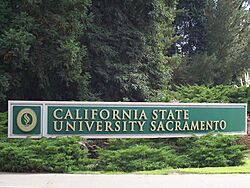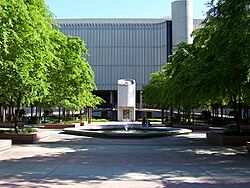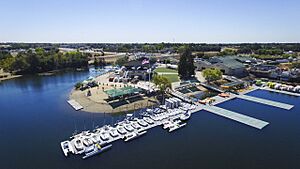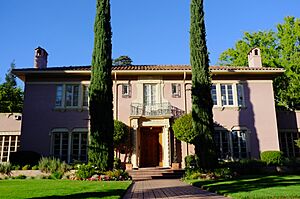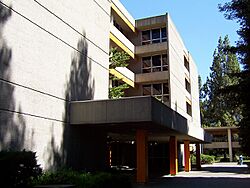California State University, Sacramento facts for kids
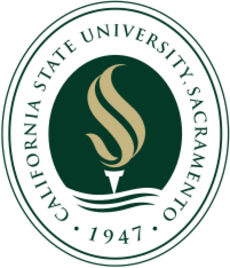 |
|
|
Former names
|
Sacramento State College (1947–1972) |
|---|---|
| Motto | "Redefine the Possible" |
| Type | Public university |
| Established | September 22, 1947 |
|
Parent institution
|
California State University |
| Accreditation | WSCUC |
|
Academic affiliations
|
Space-grant |
| Endowment | $86.42 million (2023-24) |
| Budget | $438.6 million (2024-25) |
| President | J. Luke Wood |
| Provost | Carlos Nevarez |
|
Academic staff
|
1,771 |
|
Administrative staff
|
1,270 |
| Students | 30,883 (fall 2024) |
| Undergraduates | 28,222 (fall 2024) |
| Postgraduates | 2,661 (fall 2024) |
| Location |
,
United States
|
| Campus | Large city, 305 acres (123 ha) |
| Newspaper | The State Hornet |
| Colors | Green and gold |
| Nickname | Hornets |
|
Sporting affiliations
|
|
| Mascot | Herky the Hornet |
 |
|
| Reference #: | 697 |
California State University, Sacramento (often called Sacramento State or Sac State) is a large public university in Sacramento, California. It was started in 1947 as Sacramento State College. It is part of the big California State University system.
About 30,800 students attend Sacramento State each year. Over 290,000 people have graduated from the university. Each year, about 9,000 students earn degrees. The university offers many different programs. These include 151 types of bachelor's degrees (first college degrees), 69 master's degrees (advanced degrees), and 5 doctoral degrees (the highest degrees).
The campus is very green, covering 305 acres. It has over 3,500 trees, with more than 1,200 in the University Arboretum. A special building on campus, the Julia Morgan House, is listed on the National Register of Historic Places. Sacramento State is known for being a "Tree Campus USA." It is also recognized for serving many students from diverse backgrounds.
Contents
History of Sac State
How the University Started
People wanted a four-year university in Sacramento since the 1920s. But it took a long time to make it happen. Finally, in 1947, State Senator Earl D. Desmond helped create Sacramento State College. He worked hard to get the funding approved. Many of his own family members later graduated from the college.
Sacramento State College officially opened on September 22, 1947. It shared space with Sacramento Junior College at first. Only 235 students were in the first classes. In December 1947, students chose "Herky" the Hornet as their mascot. The college colors, green and gold, were also picked. They represent the local foothills and trees. The first student, John J. Collins, graduated in the spring of 1948. By 1948, the college had sports teams in basketball, baseball, and tennis. The "Fight Hornet Fight" song was written in 1949. The student newspaper, The State Hornet, also started that year.
Finding a Permanent Home
The college needed its own campus. Several locations were considered before 244 acres of peach farmland were bought in 1949. In December 1952, the school moved to its permanent home by the American River. The new 289-acre campus opened on February 9, 1953, for about 2,400 students.
Construction on the new campus began in 1951. By 1962, 30 new buildings were ready. A famous landmark, the Guy West Bridge, was built. It looks like a smaller version of the Golden Gate Bridge and is named after the college's first president.
In 1955, the Hornet football team won its first game. In 1972, the school's name changed to California State University, Sacramento. In 2004, it officially started using "Sacramento State" as its main name. Today, Sacramento State is the only major four-year university in the city of Sacramento.
Growing Over the Years
The university grew a lot in the 1950s and beyond. Important buildings like Douglass Hall and Sacramento Hall became the heart of the campus. In 1975, the University Union opened. In 1981, the Sacramento State Aquatic Center was created. The university continued to add new buildings and spaces. In 1992, Hornet Stadium was updated to hold 26,000 people.
The campus hosted the U.S. Olympic Track and Field Trials in 2000 and 2004. In 2003, Dr. Alexander Gonzalez became the university's 11th president. He started a plan called Destination 2010 to improve programs and build new facilities.
Sac State Today
Sacramento State has seven main academic colleges and a college for continuing education. The university is also part of a group that runs Moss Landing Marine Laboratories, where students can study ocean sciences. The university uses technology to help students learn across Northern California.
The Destination 2010 plan helped build many new facilities. These include the Academic Information Research Center, a large parking structure, the new Hornet Bookstore, the Eli and Edythe Broad Athletic Fieldhouse, and the American River Courtyard residence hall.
Many new buildings have been completed or are being built:
- The Ernest E. Tschannen Science Complex: This building opened in fall 2019. It has a planetarium and an observatory for students and the public.
- University Union expansion: A large expansion of the University Union was finished in 2019. It added more space for student activities, offices, meeting rooms, and a coffee shop.
- The WELL expansion: Completed in January 2020, this project added more space for campus recreation and student health services. It includes bigger locker rooms and fitness areas.
- Riverview Hall: This residence hall opened in August 2017 and houses 416 students.
- Parking Structure 5: This structure provides parking for 1,750 vehicles.
- Hornet Commons Residence Hall: This housing project for upper-division students opened in fall 2021. It has 284 apartments and 1,100 beds.
Many famous people have visited Sacramento State to give talks or perform. These include Martin Luther King Jr. (1967), Jimi Hendrix (1968), Genesis (1992), Sheryl Crow (1995), Jesse Jackson (1998), Woody Harrelson (2001), Oliver Stone (2006), John Kerry (2004), Wangari Maathai (2009), Maya Soetoro-Ng (2009), and Chuck D (2010).
Doctoral Degrees at Sac State
In 1999, Sacramento State was allowed to offer its first Doctoral degree. This was special because, before then, only the University of California system could offer degrees beyond a Master's. This first program was a joint PhD in history with the University of California, Santa Barbara.
In 2007, the university was allowed to offer its first Doctorate in Education (Ed.D.) degree. The first students graduated in 2010. This program now offers different types of degrees.
In 2012, the university started its first Doctor of Physical Therapy (DPT) program. This program is very competitive. In 2019, Sacramento State added its newest doctoral degree, a Doctor of Audiology (Au.D).
Changing the Name
In 2004, the university started using "Sacramento State" or "Sac State" more often. Students had already been using "Sac State" for many years. The official name is still California State University, Sacramento. The university also got a new logo and seal. The exact shades of green and gold for the university's colors were also made official.
Becoming a Student
Admissions Information
Fall Statistics
| 2024 | 2023 | 2022 | 2021 | 2020 | |
|---|---|---|---|---|---|
| Freshman Applicants | 27,868 | 26,113 | 25,443 | 22,653 | 25,709 |
| Admits | 26,036 | 24,335 | 23,471 | 21,238 | 21,363 |
| % Admitted | 93.4 | 93.2 | 92.6 | 93.7 | 85.3 |
| Enrolled | 3,988 | 3,882 | 4,019 | 3,450 | 3,607 |
| Average GPA | 3.41 | 3.40 | 3.39 | 3.42 | 3.41 |
For the fall 2019 semester, 44,733 students applied to Sacramento State. This was a record number of applications. The university has seen more and more applications over the past few years.
Sacramento State is a popular choice for students transferring from California Community Colleges. More than 4,300 transfer students join the university each year. For students starting in fall 2018, 19,653 freshmen were accepted out of 27,105 applicants. This means about 72.5% of applicants were accepted. The average high school GPA (Grade Point Average) for enrolled freshmen was 3.4.
For transfer students in fall 2018, Sacramento State accepted 11,248 out of 13,578 applicants. This was an 82.8% acceptance rate. The average GPA for transfer students was 3.2.
Student Enrollment Details
About 30% of new freshmen live in the dorms on campus. In fall 2012, about half of the new freshmen came from the Sacramento area. Others came from the San Francisco Bay Area, Northern California Foothills, Southern California, other parts of the U.S., and other countries.
Most undergraduate students take about 12.2 units, which is considered full-time. For recent graduates, it took about 4.8 years to finish their degrees. Sacramento State has a high percentage of Pacific Islander American and African American students in the Cal State system.
Campus Life
On-Campus Features
| Race and ethnicity | Total | ||
|---|---|---|---|
| Hispanic | 39% |
|
|
| White | 22% |
|
|
| Asian | 20% |
|
|
| Black | 6% |
|
|
| Two or more races | 6% |
|
|
| Unknown | 3% |
|
|
| Foreign national | 2% |
|
|
| Pacific Islander | 1% |
|
|
| Economic diversity | |||
| Low-income | 57% |
|
|
| Affluent | 43% |
|
|
Sacramento State is the sixth-largest campus in the California State University system. The main campus covers 305 acres in Sacramento, right next to U.S. Route 50.
The campus is next to the American River on the east side. It has over 3,500 trees and beautiful flower gardens. There are miles of trails along the river parkway. The university is officially a "Tree Campus USA."
The Guy West Bridge, a pedestrian bridge that looks like the Golden Gate Bridge, crosses the nearby American River.
The campus has more than 30 centers for research and community service. These include the Center for California Studies and the Office of Water Programs.
The dorms on the northeastern side of campus can house 1,700 students. The Upper Eastside Lofts, near a light rail station, can house another 443 students. The university also plans to build more housing for students and faculty.
The Port of Sacramento Japanese School, a weekend Japanese school, holds its classes in Amador Hall on campus.
University Library
The Sacramento State University Library is a central part of the campus. It provides many resources for students to study and do research.
Student Housing
The student housing area has five three-story residence halls. These include Riverview Hall and the American River Courtyard. They are all around a central dining area and quad. About 2,129 students live in these dorms.
Off-Campus Locations
Sacramento State Aquatic Center
The Sacramento State Aquatic Center is located on Lake Natoma, about 15 miles east of the university. It is a partnership between the university and state departments. The center opened in 1981 and teaches many students about water sports. It is home to the Sacramento State Rowing Team and hosts national championships.
Julia Morgan House Event and Conference Center
The Julia Morgan House is about three miles west of Sacramento State. It was designed by the famous architect Julia Morgan. The house was given to the school in 1966 and added to the National Register of Historic Places in 1982. Sacramento State uses this historic home for lectures, meetings, and campus events.
Academics and Learning
University Accreditation
Since 1951, Sacramento State has been approved by the Western Association of Schools and Colleges. This means the university meets high standards for education. Sacramento State is also a Space-grant university. This means it helps with space-related research and education, especially for girls and minority students interested in engineering and computer science.
The university's specific programs are also approved by special groups. For example, business programs are approved by AACSB, and nursing programs by the Commission on Collegiate Nursing Education.
Academic Colleges
Sacramento State is divided into different colleges, each focusing on specific subjects:
- Arts & Letters
- Business
- Continuing Education
- Education
- Engineering & Computer Science
- Health & Human Services
- Natural Sciences & Mathematics
- Social Sciences & Interdisciplinary Studies
The most popular major for undergraduate students is nursing, with almost 2,000 students. Other large majors include criminal justice, psychology, Biological Sciences, and Accounting.
The university's Public Affairs division has nearly 2,700 students, making it the largest in the California State University (CSU) system. The Chemistry program is also the largest in the CSU system. Sacramento State is one of only two universities in California to offer a bachelor's degree in Deaf Studies.
The average class size at the university is 38 students. The ratio of students to teachers is about 28 to 1. Many students transfer from two-year colleges. About 750 international students from 80 countries study here. The university has the largest cooperative education program in California. This program helps students get paid jobs while earning college credit. Many students also work in government internships. About 36% of students volunteer their time.
The criminal justice program is one of the largest in North America. The College of Engineering and Computer Science is the only university in California to offer a master's degree in Electrical Engineering. It is also a national center for cyber-security. Sacramento State is the only campus in the CSU system to offer a bachelor's degree in Cinematic Arts, Digital cinematography, and professional performance.
University Rankings
|
|
|
||||||||||||||||||||||||||||||
- Sacramento State is known as one of the most diverse universities in the western United States.
- The university's bachelor's degree in gerontology (the study of aging) is ranked 5th best in the U.S. by College Choice.
- U.S. News & World Report ranked Sacramento State tied for 43rd overall among regional universities in the western U.S. in 2021. It was also tied for 20th best public school and tied for 46th best undergraduate engineering program.
- Sacramento State has been called one of the "greenest" campuses in the world.
- In March 2018, Sacramento State's Jazz Ensemble was named one of the nation's top three college jazz bands.
- In 2019, Sacramento State's Master of Science in Accountancy program was ranked 3rd nationally for Best Online Program by OnlineU.
Economic Impact
Sacramento State helps the economy of the Sacramento Region and California. It supports almost 9,000 jobs and brings in over $816 million to the Sacramento economy each year. The university's spending is more than $600 million annually.
The campus has the largest co-operative education program in the state. Students get paid jobs and earn academic credit. For example, biology students help with DNA matching in the Sacramento crime lab. Physical Therapy students help stroke victims, and government students work at the Capitol. Almost 36% of students volunteer through the Sacramento State Serves program, giving over 2 million hours of service each year.
Research and Support Centers
The campus has over 30 research centers. Some important ones include:
- California Smart Grid Center (works on smart energy systems)
- Archaeological Research Center
- Center for African Peace and Conflict Resolution
- Center for California Studies (hosts Capitol Fellows)
- Office of Water Programs
- North Central Information Center
- STEM Research
- Sustainable Technology Optimization Research Center
CAMP/HEP Center
The College Assistance Migrant Program (CAMP) and High School Equivalent Program (HEP) help students from migrant or seasonal farm worker families. These programs help them get a high school diploma and then go to college. Sacramento State has a grant to help 70 new freshmen and 300 continuing students each year. The program helps over 7,000 people annually.
Capital Fellows Program
Sacramento State works with the California State government on the Capital Fellowship program. This program allows students to work in the state government. Fellows get to learn about public service and help create public policy in California. Many former fellows have gone on to important careers in government and other fields.
Center for Collaborative Policy
This center helps solve disagreements between different groups or government agencies. It uses methods like mediation and negotiation to find solutions that work for everyone. This helps avoid arguments and legal battles.
Sports and Athletics
The university offers 21 different sports teams. In 2013, Women's Beach Volleyball was added as the 21st sport. Sacramento State sports teams compete in NCAA Division I. The university's colors are green and gold. Their nickname is the Hornets, and their mascot is Herky the Hornet. The common phrase used by fans is Stingers Up!
Most athletic teams compete in the Big Sky Conference. Sacramento State is the only school from California in the Big Sky. The football and track and field teams play in Hornet Stadium. Baseball is played at John Smith Field. Volleyball, basketball, and gymnastics teams play at Colberg Court.
In 2003 and from 2005 to 2007, the university hosted the NCAA Track and Field Championship at Hornet Stadium.
University Organizations
Sacramento State has several organizations that help the university run smoothly.
Air Force and Army ROTC
The school hosts the Air Force Reserve Officer Training Corps (ROTC), Detachment 088. This program trains future US Air Force officers from Sacramento State and University of California Davis. It is the largest Air Force ROTC program in Northern California.
The Army ROTC program also exists on campus. In 2002, this program received a special award for leadership.

Associated Students Inc. (ASI)
Associated Students Inc. (ASI) is a non-profit group that provides programs, services, and student government for Sacramento State. Students elect a Board of Directors to lead ASI. ASI has a budget of over $10 million, which comes from student fees and programs like Peak Adventures and the Aquatic Center.
ASI Children's Center
ASI offers a day care center for children of faculty, staff, and students. It cares for children from newborn to five years old. The center is approved by the NAEYC, which means it meets high standards for child care. Students studying Child Development can work at the center.
Capital Public Radio, Inc.
Sacramento State owns and operates several public radio stations in California with Capital Public Radio. These include KXPR (classical and jazz music) and KXJZ (news and talk shows). Both stations broadcast without commercials and are supported by listeners. They also carry programs from National Public Radio.
KSSU 1580 AM
KSSU 1580AM is a non-profit student radio station at Sacramento State. It has a small signal that mostly covers the campus, but you can listen online at kssu.com. KSSU is known as one of the best college radio stations in North America. In 2007 and 2008, it won awards from the College Music Journal. In 2008, MTVU also nominated KSSU for College Radio Station of the Year.
The State Hornet Newspaper
The State Hornet is Sacramento State's student newspaper. It publishes issues each semester and updates its website daily. The newspaper staff from 1999–2000 won the National Newspaper Pacemaker Award, which is a very high honor in college journalism. In 2012, the newspaper was again a finalist for this award.
University Union
The University Union is the main student activity center at Sac State. It opened in 1975 and has been updated many times. It has a large food court, a game room, computers with internet, free WiFi, meeting rooms, and offices for student groups.
An expansion of the University Union was completed in August 2018. This added 71,000 square feet of space. It includes a Starbucks, more meeting rooms, study lounges, and outdoor seating.
Student Clubs and Groups
Sacramento State has many social and academic clubs and organizations. These groups help students with similar interests connect and work together. They offer many ways to get involved in campus life. Some groups represent national or international organizations, while others focus on specific cultures, politics, or hobbies.
In fall 2012, about 7% of undergraduate men were part of fraternities, and 5% of undergraduate women were part of sororities. This means about 1,500 students were involved in Greek life.
Getting Around Campus
University Transportation and Parking Services (UTAPS) runs the Hornet Shuttle buses. These buses provide several routes around campus from about 7:30 am to 5:00 pm. The Hornet Line serves the south end of campus, the light-rail station, and Folsom Hall. The Green Line serves the College Town area, and the Gold Line goes to the Fair Oaks district and the Arden Fair Mall. UTAPS also has a night shuttle service for students until 11:00 pm.
The university has a bus terminal where Sacramento Regional Transit buses stop. These buses connect the university to downtown, Midtown, and other areas. The university is also about half a mile from the University/65th Street station on the SacRT light rail system. Sacramento State students can use these public transportation services for free with their student One Card.
The university also has Zipcars on campus that students, faculty, and staff can rent 24 hours a day.
The school is located just north of US 50 and can be reached by two exits: 65th St. and Howe Avenue.
Famous People from Sac State
Over 250,000 people have graduated from Sacramento State since it started. Many alumni live in California, but also in other states like Washington, Oregon, and Texas. Nearly 1,000 alumni live in about 62 different countries.
-
Tom Hanks, Academy Award Winning Actor
-
Ryan Coogler, Academy Award Nominated Director
-
Buck Martinez, Toronto Blue Jays manager
University Presidents
Here is a list of the presidents who have led Sacramento State:
- Guy A. West (1947–1965)
- F. Blair Mayne (1965)
- Stephen L. Walker (1965–1966)
- Robert Johns (1966–1969)
- Otto Butz (1969–1970)
- Bernard L. Hyink (1970–1972)
- James G. Bond (1972–1978)
- W. Lloyd Johns (1978–1983)
- Austin J. Gerber (1983–1984)
- Donald R. Gerth (1984–2003)
- Alexander Gonzalez (2003–2015)
- Robert S. Nelsen (2015–2023)
- J. Luke Wood (2023–present)
See also
 In Spanish: Universidad Estatal de Sacramento para niños
In Spanish: Universidad Estatal de Sacramento para niños
- Causeway Classic


